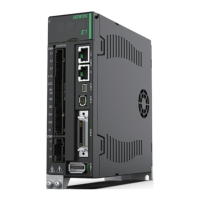E1 Series Servo Drive User Manual Trial Operation When Connected To Controller
9-4 HIWIN MIKROSYSTEM CORP.
Step 8: Input low-speed pulse commands from the controller for trial operation. For safety, the velocity
must not exceed:
Rotary motor: 100 rpm
Linear motor: 100 mm/s
Step 9: Check if the moving direction of the servo motor is in accordance with the direction defined by
the controller. If the moving direction is different, change the setting by referring to section 6.6.
Step 10: Check if the received command pulses are in accordance with the position commands from the
controller.
Step 11: Click on to open Interface signal monitor window and record the variation of Pulse
input. Check if the actual moving distance is the same with the received pulses.
Step 12: Click on to open Interface signal monitor window and record the variation of AqB
encoder or Serial encoder.
Step 13: Check if the variations of Pulse input and feedback pulse counter (AqB encoder or Serial
Encoder) satisfy the following calculation:
Variation of position command = Variation of feedback pulse counter × (Pt20E/Pt210)
Step 14: Input pulse command from the controller and let the motor operate at the maximum required
velocity of the machine.
Step 15: Use Scope in Thunder to monitor Position reference velocity. Check the velocity of the pulse
input into the servo drive by the input command pulse velocity monitoring.
Thunder
The input command pulse velocity monitoring uses the following formulas.
Rotary motor (23-bit encoder)
Input command pulse velocity monitoring =
Input command pulse velocity (pulse/s) × 60 ×
20
210
×
1
2
23
(= 8388608)
Input command pulse velocity/min

